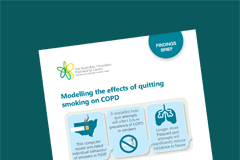Modelling the effects of quitting smoking on COPD
This project was the first in Australia to develop a dynamic simulation model to forecast the population health implications of smoking behaviour on COPD over the next 50 years. It found longer and more frequent quit attempts will lead to less COPD among smokers in future. Download the Findings Brief to learn the relevance of this project for policy and practice.
Key messages
- Chronic obstructive pulmonary disease (COPD) has a significant impact on mortality, the health system and quality of life, and is estimated to cost Australia more than $7.7 billion per year.
- The probability of developing COPD is directly linked to amount of tobacco smoked over a lifetime.
- Smoking rates have declined in Australia in recent years, but we do not know how this will impact the COPD burden in future.
- Dynamic simulation modelling is a useful ‘what-if’ tool that enables testing of the likely impact of a range of possible scenarios over time.
- This project was the first in Australia to develop a dynamic simulation model to forecast the population health implications of smoking behaviour on COPD over the next 50 years.
- We found that longer and more frequent quit attempts will lead to less COPD among smokers in future. Any intervention that supports this would have significant benefits, and much greater than has been shown in the literature previously.
- These findings suggest that identifying smokers who are likely to quit for longer and providing them with targeted support has the potential to substantially reduce the burden of COPD in NSW.

